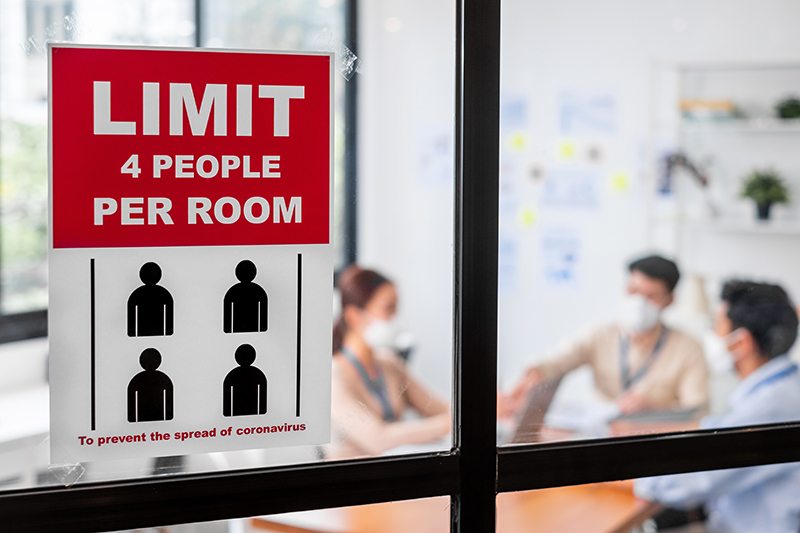

Features
Future of Work
Health & Safety
Managing/Leadership
Working Remotely
The new modern workplace: resets, rethinks and the great leap forward
By Anthony Ariganello
 Architects and designers say this is a time of experimentation and reflection for employers. (Nattakorn/Adobe Stock)
Architects and designers say this is a time of experimentation and reflection for employers. (Nattakorn/Adobe Stock) Over a year ago, the world of work changed overnight, as did our lives.
Together, but apart, we have faced a health crisis unlike any other, one on a global scale that has touched us all on an individual basis. Whether we have lost loved ones, jobs or entire businesses, the past year been both catastrophic and a catalyst for better times to come.
What we have endured and what we should expect moving forward is not so much a reset for the modern workplace as it is a great leap forward. We have seen innovation unleashed on an exponential level, while at the same time realizing the overall effectiveness of a mostly remote workforce.
Mindful of the losses suffered, the pandemic has challenged us all, but it has also accelerated a world of positive change that had been deadlocked in discussion for years.
Now, with vaccinations making their way into global distribution, albeit unevenly, a light is emerging at the end of the tunnel.
However, as our focus shifts towards what the new normal on the other side of that tunnel looks like, there is no denying that the world of work has been forever changed — and in many cases for the better.
A change in leadership mindset
This has come about in no small part by a long overdue change of thinking spurred by pure necessity.
Even those leaders who are better equipped to manage change than most have really had to turn to their HR people to help deal with what has been a daily deluge of challenges arising almost exclusively around people matters — from pandemic fears to sick leaves and the rise of mental health issues — all while trying to keep their core businesses afloat.
If there is one thing the pandemic exposed glaringly, it is the need for inspired leadership at a root level. During good times, leaders don’t truly matter as much, but in times of extended crises, their presence alone can inspire the confidence needed to adapt and survive.
As a result, for those in HR profession, the past year provided nothing less than a proving ground for a skill and mindset that has never been more called upon by leadership in every part of organizations.
That mindset is hinged upon keeping people first in the minds of decision-makers, and as has become readily apparent at all levels of industry and government, the need for people-first leadership is greater than ever.
More importantly, it is also likely to be the minimum bar of entry for organizations looking to thrive in our new reality.
A trend towards flexible futures
As per the findings of CPHR Canada’s 2020 HR Trends Report with Insights West, what has changed most is the thinking around the physical workplace itself.
Drawing upon the representative bodies of CPHR BC & Yukon, Alberta, Saskatchewan and Manitoba, the survey pointed to a way of thinking at once completely new — and yet both familiar and welcome to HR professionals.
While only one in three employers had or offered remote working possibilities pre-pandemic, that number surged to 94 per cent in pandemic times.
Interestingly, looking past the public health emergency phase, over two-thirds of employers surveyed are factoring flexible work arrangements — with one in five aiming to have as many employees working remotely as possible.
And while these numbers vary from the province to province — with the West Coast taking a significant lead in introducing and/or considering new flexible work options — the trend towards flexibility and the employee experience rings true throughout.
That is welcome thinking to a profession which has always espoused the strategic value of both for some time.
Keeping the connections alive
From an HR perspective, these numbers are telling, filling in the details of a picture that has been evolving for some time and will invariably continue to do so as the new modern workplace begins to take form in a world without many old norms.
Without a doubt, the future workplace will be nothing if not dynamic — a hybrid of time-tested best practice wed with a wonderland of previously underused technological potential and workplace flexibility.
As such, continuing to develop and utilize the range of connectivity tools at our disposal is essential, and has been discovered by teams large and small, more specifically-oriented and accessible than just 12 months ago.
From Zoom to Microsoft Teams to Sharepoint, Yammer, Slack, Twitter, Chatter, Jive and a host of other platforms, we have all grown as technological adepts and that needs to continue.
As a membership-based body that thrives in face-to-face medium such as our annual conference and multiple symposiums, CPHR BC & Yukon has nonetheless thrived with a host of online offerings.
These have ranged from weekly Wake Up and Wind Down zooms to hot-button webinars targeting key COVID-19 matters to a greater wealth of ongoing special events than we might have ever had need to consider.
Maintaining that connectivity, particularly within a profession or team with a passion for learning, has been a rewarding challenge that has also laid a roadmap for opportunities previously unconsidered.
Return to normal unlikely
For all the challenges we have faced in isolation, they will only become more manifest as we come together.
One need only consider the scenario of someone disinclined to be vaccinated wanting to return to the physical workplace to see that basic truth, but beyond the varying provincial laws which govern such matters, it is the day-to-day that will define the shape of workplaces to come.
From creating ergonomically spaced workplaces to being able to ensure a safe workplace to addressing the issue of additional sick days due to COVID-19 concerns, the issues ahead are many.
Forging a people-first workplace
Answering the call, as HR professionals we have had the opportunity to incorporate a lot of new thinking into a lifetime of learning from inspiring conferences, books and podcasts. More importantly, we had to put those learnings to the test.
As a result, not only are larger swaths of leadership realizing HR as an essential business partner, but the profession itself exudes newfound confidence as topics well learned have been transformed into skill sets well earned.
In a very real sense, while the past year has felt interminable, we have actually stepped into something of a time machine in terms of “business as usual.”
Whether we would have adapted as quickly and effectively without being forced into it is a point worth considering as we aim to consolidate a new sense of normalcy — as maintaining that dynamism is key to culture, communications and commerce alike.
For some businesses, the time away from the office is leading towards a far less physical future. For others, the return to brick-and-mortar space is mandated by the business model itself, albeit with a bit more space around the water cooler.
Between these two hyperbolic ends, we can expect manifold combinations as we begin to rebuild, not anew, but with a new sense of shared humanity, and a definitive confidence in our previously untapped abilities to get the job done, regardless of setting.
As for sticking the landing in this great leap forward, therein lies the challenge for every workplace, but by remaining flexible, engaging and people-minded, the landing may prove less important than the human momentum we build.

Anthony Ariganello is president and CEO of Chartered Professionals in Human Resources Canada (CPHR Canada), with headquarters in Vancouver.
Print this page